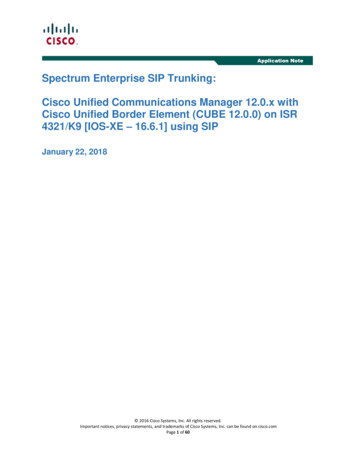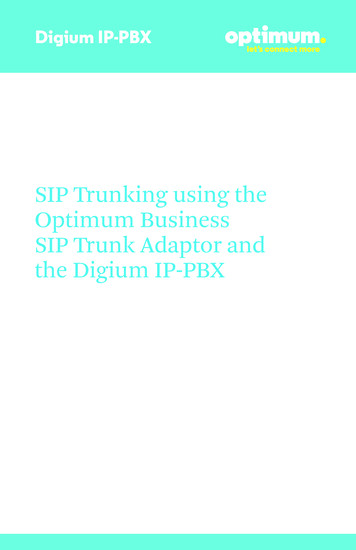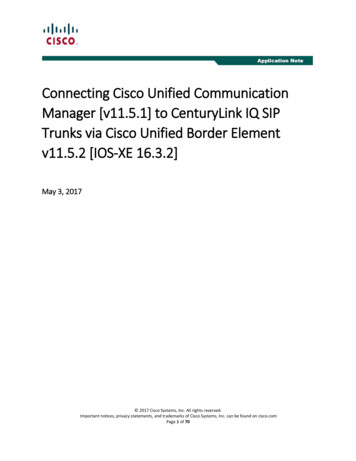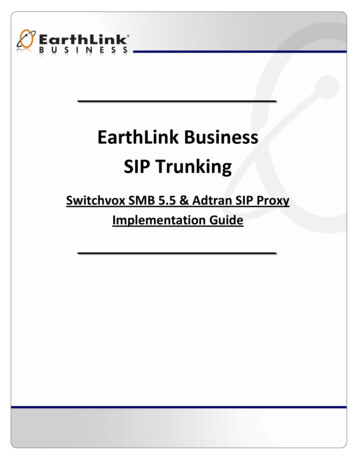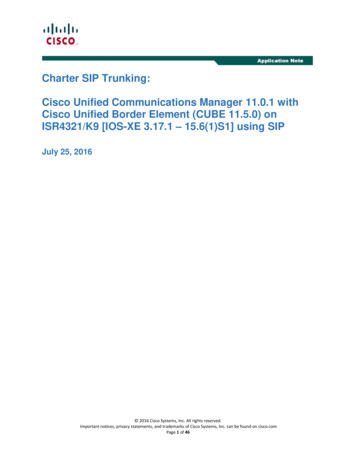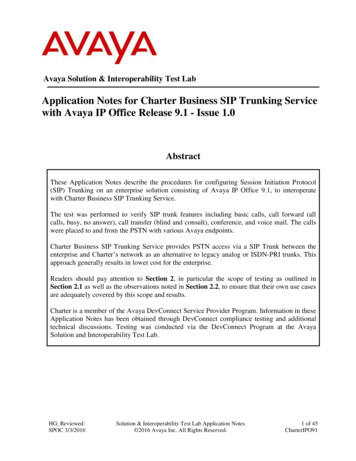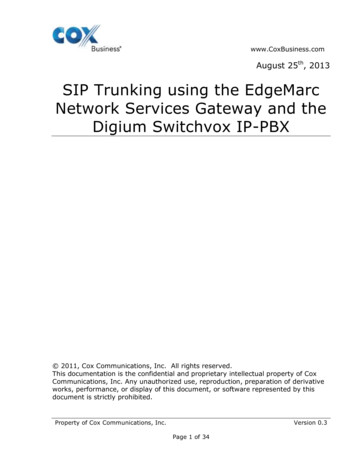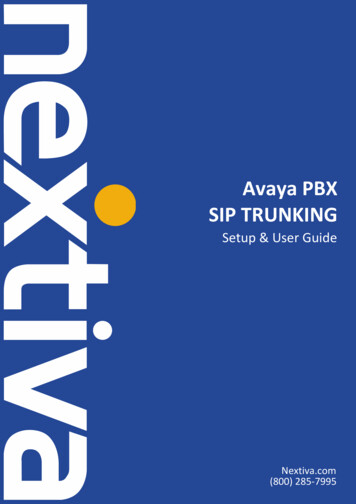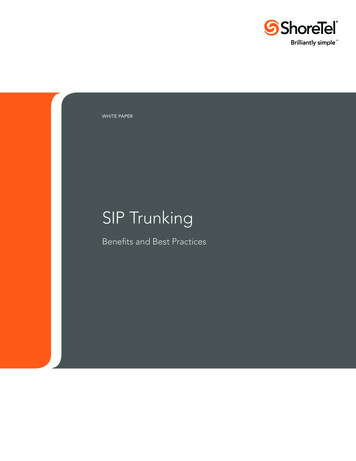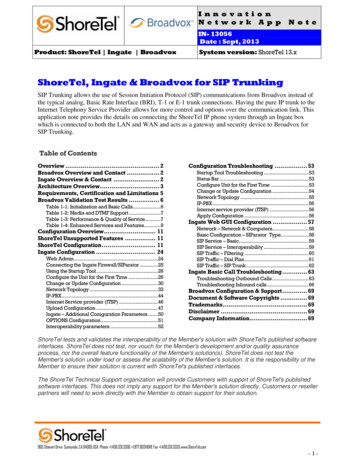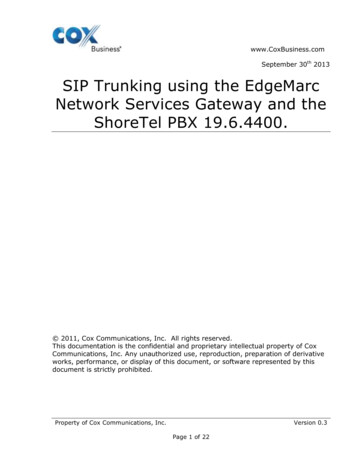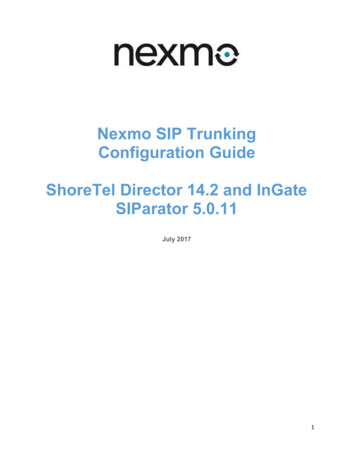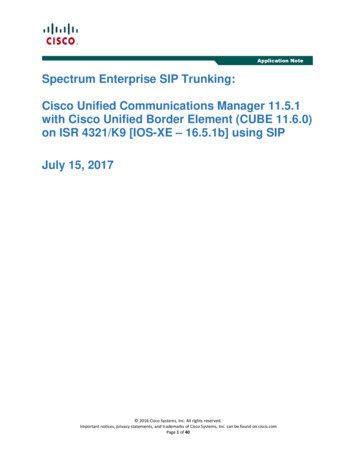
Transcription
Spectrum Enterprise SIP Trunking:Cisco Unified Communications Manager 11.5.1with Cisco Unified Border Element (CUBE 11.6.0)on ISR 4321/K9 [IOS-XE – 16.5.1b] using SIPJuly 15, 2017 2016 Cisco Systems, Inc. All rights reserved.Important notices, privacy statements, and trademarks of Cisco Systems, Inc. can be found on cisco.comPage 1 of 40
Table of ContentsIntroduction. 4Network Topology . 5System Components . 6Hardware Requirements. 6Software Requirements . 6Features . 7Features Supported . 7Features Not Supported . 7Caveats . 7Configuration . 8Configuring Cisco Unified Border Element . 8Network Interface . 8Global Cisco UBE Settings . 9Codecs . 9Dial Peer . 10Call Flow . 11Configuration Example . 14Configuring Cisco Unified Communications Manager . 26Cisco UCM Version. 26Cisco Call Manager Service Parameters. 26Offnet Calls via Spectrum Enterprise SIP Trunk . 27Dial Plan. 34Acronyms . 38Important Information. 39 2016 Cisco Systems, Inc. All rights reserved.Important notices, privacy statements, and trademarks of Cisco Systems, Inc. can be found on cisco.comPage 2 of 40
Table of FiguresFigure 1: Network Topology . 5Figure 2: Cisco UBE High Availability . 5Figure 3: Outbound Voice Call . 12Figure 4: Inbound Voice Call . 12Figure 5: Outbound Fax Call . 13Figure 6: Inbound Fax Call . 13Figure 7: PBX to PBX via Spectrum Call . 13Figure 8: Cisco UCM Version . 26Figure 9: Service Parameters. 26Figure 10: SIP Trunk Security Profile . 27Figure 11: SIP Profile. 28Figure 12: SIP Profile (Cont.) . 29Figure 13: SIP Profile (Cont.) . 30Figure 14: SIP Trunks List . 31Figure 15: SIP Trunk to Cisco UBE . 31Figure 16: SIP Trunk to Cisco UBE (Cont.). 32Figure 17: SIP Trunk to Cisco UBE (Cont.). 33Figure 18: Route Patterns List . 34Figure 19: Route Pattern for Voice . 35Figure 20: Route Pattern for Voice (Cont.) . 36Figure 21: Route Pattern for Fax . 37 2016 Cisco Systems, Inc. All rights reserved.Important notices, privacy statements, and trademarks of Cisco Systems, Inc. can be found on cisco.comPage 3 of 40
IntroductionService Providers today, such as Spectrum Enterprise, are offering alternative methods to connect to thePSTN via their IP networks. Most of these services utilize SIP as the primary signaling method andcentralized IP to TDM POP gateways to provide on-net and off-net services.A demarcation device between these services and customer owned services is recommended. As anintermediary device between Cisco Unified Communications Manager and Spectrum network, CiscoUnified Border Element (Cisco UBE) ISR 4321/K9 running IOS-XE 16.5.1b can be used. The CiscoUnified Border Element provides demarcation, security, interworking and session control services forCisco Unified Communications Manager 11.5.1 connected to Spectrum network.This document assumes the reader is knowledgeable with the terminology and configuration of CiscoUCM (Cisco Unified Communications Manager). Only configuration settings specifically required forSpectrum Enterprise interoperability are presented. Feature configuration and most importantly the dialplan are customer specific and need individual approach. This application note describes how to configure a Cisco Unified Communications Manager (CiscoUCM) 11.5.1 and Cisco Unified Border Element (Cisco UBE) on ISR 4321/K9 [IOS-XE 16.5.1b] forconnectivity to Spectrum Enterprise SIP Trunking service available in the former Charter SpectrumBusiness service area1 (hereafter referred to as Spectrum Enterprise (L-Charter)). The deploymentmodel covered in this application note is CPE (Cisco UCM 11.5.1) to PSTN (Spectrum Enterprise). Testing was performed in accordance to Spectrum Enterprise generic SIP Trunking testmethodology and among features verified were – basic calls, DTMF transport, Music on Hold(MOH), unattended and attended transfers, call forward, conferences and interoperability withCisco Unity Connection (CUC). The Cisco UCM configuration detailed in this document is based on a lab environment with asimple dial-plan used to ensure proper interoperability between Spectrum Enterprise (L-Charter)SIP network and Cisco Unified Communications. The configuration described in this documentdetails the important configuration settings to have enabled for interoperability to be successful andcare must be taken by the network administrator deploying Cisco UCM to interoperate to SpectrumEnterprise (L-Charter) SIP Trunking network.This application note does not cover the use of Calling Search Spaces (CSS) or partitions on Cisco UCM.To understand and learn how to apply CSS and partitions refer to the cisco.com link below:http://www.cisco.com/c/en/us/td/docs/voice ip ers to the former Charter Spectrum Business service area for SIP trunking, prior to the acquisition ofTime Warner Cable and BrightHouse Networks in 2016. 2016 Cisco Systems, Inc. All rights reserved.Important notices, privacy statements, and trademarks of Cisco Systems, Inc. can be found on cisco.comPage 4 of 40
Network TopologyFigure 1: Network TopologyFigure 2: Cisco UBE High Availability 2016 Cisco Systems, Inc. All rights reserved.Important notices, privacy statements, and trademarks of Cisco Systems, Inc. can be found on cisco.comPage 5 of 40
System ComponentsHardware Requirements Cisco UCSC-C240-M3S VMWare host running ESXi 5.5 StandardCisco ISR4431/K9 router as CUBECisco ISR4431/K9 (1RU) processor with 1684579K/6147K bytes of memory with 4Gigabit Ethernet interfacesProcessor board ID FTX1845AJ9SCisco 2851 Fax GatewayIP phones 9971 (SIP) and 8945 (SIP)Adtran Total Access 908e 2nd Gen – Provided and managed by Spectrum EnterpriseSoftware Requirements Cisco Unified Communications Manager 11.5.1Cisco Unity Connection 11.5.1IOS-XE 16.5.1b for ISR 4321/K9 Cisco Unified Border ElementIOS 15.1(4)M5 for Cisco 2851 Fax GatewayAdtran Total Access 908e 2nd Gen /R11.4.6.E - Provided and managed by SpectrumEnterprise 2016 Cisco Systems, Inc. All rights reserved.Important notices, privacy statements, and trademarks of Cisco Systems, Inc. can be found on cisco.comPage 6 of 40
FeaturesFeatures Supported Incoming and outgoing off-net calls using G711ULawCall holdCall transfer (unattended and attended)Call conferenceCall forward (all, busy and no answer)Calling Line (number) Identification Presentation (CLIP)Calling Line (number) Identification Restriction (CLIR)DTMF relay (both directions) (RFC2833)Media flow-through on Cisco UBEFax (G.711 pass-through)Features Not Supported Cisco IP phones used in this test do not support blind transferFax (T.38) and G729 is not supported by Spectrum Enterprise (L-Charter)In HA redundancy mode, the primary cube will not take over the primary/active role aftera reboot/network outageCaveats Caller ID is not updated after attended or unattended transfers to off-net phones. This isdue to a limitation on Cisco UBE and will be resolved in the next release. The issue doesnot impact the calls. For testing, 911 calls were terminated by Spectrum Enterprise 2016 Cisco Systems, Inc. All rights reserved.Important notices, privacy statements, and trademarks of Cisco Systems, Inc. can be found on cisco.comPage 7 of 40
ConfigurationConfiguring Cisco Unified Border ElementNetwork InterfaceConfigure Ethernet IP address and sub interface. The IP address and VLAN encapsulation used are forillustration only, the actual IP address can vary. For SIP trunks two IP addresses must be configured - forLAN and WAN.interface GigabitEthernet0/0/0ip address 10.64.4.19 255.255.0.0negotiation autoredundancy rii 1redundancy group 1 ip 10.64.4.30 exclusive!interface GigabitEthernet0/0/2ip address 10.80.11.17 255.255.255.0negotiation autoredundancy rii 2redundancy group 1 ip 10.80.11.20 exclusive 2016 Cisco Systems, Inc. All rights reserved.Important notices, privacy statements, and trademarks of Cisco Systems, Inc. can be found on cisco.comPage 8 of 40
Global Cisco UBE SettingsIn order to enable Cisco UBE IP2IP gateway functionality, enter the following:voice service voipno ip address trusted authenticatemode border-elementallow-connections sip to sipredundancy-group 1fax protocol pass-through g711ulawsiprel1xx supported "rel100"header-passingasserted-id paiearly-offer forcedmidcall-signaling passthruprivacy-policy ions sip to sipAllow IP2IP connections between two SIP call legsfax protocolSpecifies the fax protocolasserted-idSpecifies the type of privacy header in the outgoing SIPrequests and response messagesearly-offer forcedEnables SIP Delayed-Offer to Early-Offer globallymidcall-signaling passthruPasses SIP messages from one IP leg to another IP legCodecsG711Ulaw is used as the preferred codec for this testing and changed the preferencesaccording to the test plan description 2016 Cisco Systems, Inc. All rights reserved.Important notices, privacy statements, and trademarks of Cisco Systems, Inc. can be found on cisco.comPage 9 of 40
voice class codec 1codec preference 1 g711ulawcodec preference 2 g729r8Dial PeerCisco UBE uses dial-peers to route the call accordingly based on the digitsdial-peer voice 10 voipdescription Incoming from CUCMhuntstopsession protocol sipv2incoming called-number [0-9]Tvoice-class codec 1voice-class sip bind control source-interface GigabitEthernet0/0/2voice-class sip bind media source-interface GigabitEthernet0/0/2dtmf-relay rtp-ntefax-relay ecm disablefax rate disablefax protocol pass-through g711ulawno vad!dial-peer voice 20 voipdescription Outgoing to Adtranhuntstopdestination-pattern [0-9]Tsession protocol sipv2session target ipv4:10.64.4.18:5060voice-class codec 1voice-class sip profiles 100voice-class sip bind control source-interface GigabitEthernet0/0/0voice-class sip bind media source-interface GigabitEthernet0/0/0dtmf-relay rtp-ntefax-relay ecm disablefax rate disablefax protocol pass-through g711ulawno vad!dial-peer voice 30 voip 2016 Cisco Systems, Inc. All rights reserved.Important notices, privacy statements, and trademarks of Cisco Systems, Inc. can be found on cisco.comPage 10 of 40
description Incoming from Adtranhuntstopsession protocol sipv2incoming called-number [37][02][30]Tvoice-class codec 1voice-class sip bind control source-interface GigabitEthernet0/0/0voice-class sip bind media source-interface GigabitEthernet0/0/0dtmf-relay rtp-ntefax-relay ecm disablefax rate disablefax protocol pass-through g711ulawno vad!dial-peer voice 40 voipdescription Outgoing to CUCMhuntstopdestination-pattern [37][02][30]Tsession protocol sipv2session target ipv4:10.80.11.2voice-class codec 1voice-class sip bind control source-interface GigabitEthernet0/0/2voice-class sip bind media source-interface GigabitEthernet0/0/2dtmf-relay rtp-ntefax-relay ecm disablefax rate disablefax protocol pass-through g711ulawno vad!Call FlowIn the sample configuration presented here, Cisco UCM is provisioned with four-digit directory numberscorresponding to the last four DID digits. No digit manipulation is performed on the Cisco UBE.For incoming PSTN calls, the Cisco UBE presents the full ten-digit DID number to Cisco UCM. The CiscoUCM picks up the last 4 significant Digits configured under SIP Trunk and routes the call based on those 4 2016 Cisco Systems, Inc. All rights reserved.Important notices, privacy statements, and trademarks of Cisco Systems, Inc. can be found on cisco.comPage 11 of 40
digits. Voice calls are routed to IP phones; Fax calls are routed via a 4-digit route pattern over a SIP trunkthat terminates on the Fax Gateway and in turn to the VentaFax client connected to the Fax Gateway.CPE callers make outbound PSTN calls by dialing a “9” prefix followed by the destination number. Foroutbound fax calls from the analog fax endpoint, Cisco fax Gateway sends to Cisco UCM the DID withleading access code “9”. A “9.@” route pattern strips the prefix and routes the call with the remaining digitsvia a SIP trunk terminating on the Cisco UBE for Voice call or Fax. For PBX to PBX via Spectrum Enterprise,Caller dial 9 prefix followed by the target 1 10Digit DID no for that extension number, 9 was stripped andthe 1 10 digits number was send to Cisco UBE, Cisco UBE sends the full 1 10 digits DID under DialPeer 200 and send to Spectrum network which will direct back to Cisco UBE and handled same as normalincoming PSTN call. For International calls same pattern 9 followed by 011, country code and calling no isused.Figure 3: Outbound Voice CallFigure 4: Inbound Voice Call 2016 Cisco Systems, Inc. All rights reserved.Important notices, privacy statements, and trademarks of Cisco Systems, Inc. can be found on cisco.comPage 12 of 40
Figure 5: Outbound Fax CallFigure 6: Inbound Fax CallFigure 7: PBX to PBX via Spectrum Call 2016 Cisco Systems, Inc. All rights reserved.Important notices, privacy statements, and trademarks of Cisco Systems, Inc. can be found on cisco.comPage 13 of 40
Configuration ExampleThe following configuration snippet contains a sample configuration of Cisco UBE with allparameters mentioned previouslyActive Cisco UBEUser Access VerificationUsername:Password:isr4k1spectrum#sh running-configBuilding configuration.Current configuration : 5286 bytes!! Last configuration change at 06:17:09 UTC Tue May 30 2017 by cisco!version 16.5service timestamps debug datetime msecservice timestamps log datetime msecservice password-encryptionplatform qfp utilization monitor load 80no platform punt-keepalive disable-kernel-core!hostname f definition Mgmt-intf!address-family ipv4exit-address-family!address-family ipv6exit-address-family!logging console emergenciesenable secret 5 1 JbZh 5I3Lr7oSNCAEcKgkNMyGP0!no aaa new-model 2016 Cisco Systems, Inc. All rights reserved.Important notices, privacy statements, and trademarks of Cisco Systems, Inc. can be found on cisco.comPage 14 of 40
!ipv6 unicast-routing!subscriber templating!multilink bundle-name authenticated!crypto pki trustpoint TP-self-signed-1179880555enrollment selfsignedsubject-name cn heck nonersakeypair TP-self-signed-1179880555!crypto pki certificate chain TP-self-signed-1179880555!voice service voipno ip address trusted authenticatemode border-elementallow-connections sip to sipredundancy-group 1fax protocol pass-through g711ulawsiprel1xx supported "rel100"header-passingasserted-id paiearly-offer forcedmidcall-signaling passthruprivacy-policy passthru!voice class codec 1codec preference 1 g711ulawcodec preference 2 g729r8!voice class sip-profiles 100request INVITE sip-header Diversion modify " sip:(.*)@(.*) " " sip:303835\1@\2"!voice-card 0/1no watchdog 2016 Cisco Systems, Inc. All rights reserved.Important notices, privacy statements, and trademarks of Cisco Systems,
Offnet Calls via Spectrum Enterprise SIP Trunk . (L-Charter) SIP network and Cisco Unified Communications. The configuration described in this document details the important configuration settings
